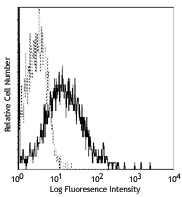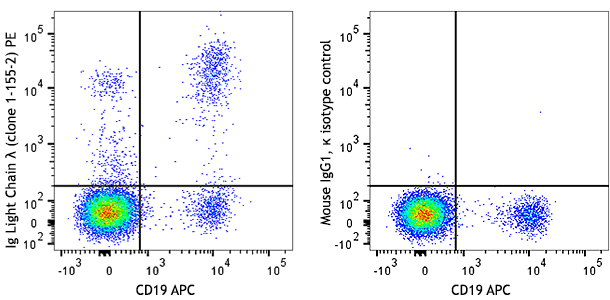- Regulatory Status
- RUO
- Other Names
- TGF-β1 (Free Active Form or Total Form)
- Ave. Rating
- Submit a Review
- Product Citations
- publications
| Cat # | Size | Price | Quantity Check Availability | Save | ||
|---|---|---|---|---|---|---|
| 740489 | 100 tests | $470 | ||||
The LEGENDplex™ Mouse/Rat Free Active/Total TGF-β1 Assay is a single plex bead-based assay, using fluorescence–encoded beads suitable for use on various flow cytometers. This assay allows quantification of either free active TGF-β1 without sample treatment or total TGF-β1 after sample treatment. It provides high detection sensitivities and broad dynamic range. The assay has been validated for use with serum, plasma, cell culture supernatant samples.
Product DetailsKit Details
- Kit Contents
-
- Setup Beads: PE Beads
- Setup Beads: Raw Beads
- Capture Beads
- Detection Antibodies
- Standard Cocktail, Lyophilized
- Acidification Solution
- Neutralization Solution
- Sample Diluent
- SA-PE
- Matrix C1, Lyophilized
- Assay Buffer
- Wash Buffer
- Plate Sealers
- Filter Plate
- Materials Not Included
-
- Flow Cytometer
- Pipettes and Tips
- Reagent Reservoirs for Multichannel Pipettes
- Polypropylene Microfuge Tubes
- Vortex Mixer
- Sonicator
- Aluminum Foil
- Absorbent Pads or Paper Towels
- Plate Shaker
- Tabletop Centrifuges
- A Vacuum Filtration Unit and a Vacuum Source (if using filter plates)
Product Details
- Verified Reactivity
- Mouse, Rat
- Application
-
Multiplex
Learn more about LEGENDplex™ at biolegend.com/legendplex
Download the LEGENDplex™ software here. - Application Notes
-
The assay is able to detect free active TGF-ß1 without sample treatment or total TGF-ß1 after sample treatment. This assay has been fully verified for mouse/rat as well as human samples. Though not specifically tested, there is an expected cross reactivity with multiple species of non-human primates. There is > 99% amino acid identity conservation between the human sequence and that of the Rhesus macaque (M. mulatta), Cynomolgous macaque (M. fascicularis), Chimpanzee (genus Pan), and Baboon (genus Papio); species which comprise the vast majority of primates used in current Biomedical Research.
- Materials Not Included
-
- Flow Cytometer
- Pipettes and Tips
- Reagent Reservoirs for Multichannel Pipettes
- Polypropylene Microfuge Tubes
- Vortex Mixer
- Sonicator
- Aluminum Foil
- Absorbent Pads or Paper Towels
- Plate Shaker
- Tabletop Centrifuges
- A Vacuum Filtration Unit and a Vacuum Source (if using filter plates)
Antigen Details
- Biology Area
- Apoptosis/Tumor Suppressors/Cell Death, Cell Biology, Immunology, Neuroinflammation, Neuroscience, Signal Transduction
- Molecular Family
- Cytokines/Chemokines, Growth Factors
- Gene ID
- 21803 View all products for this Gene ID
Related Pages & Pathways
Pages
Related FAQs
- If I don't have a vacuum, how do I remove the liquid from my plate?
-
If you do not have a vacuum, the assay should be run in a V-bottom plate. After centrifugation using a swinging-bucket rotor with a plate adaptor, you can remove the liquid by flicking the plate quickly, dumping the contents into a sink, and patting it dry carefully on a stack of clean paper towels without losing the beads. Alternatively, you can remove the liquid by using a pipette.
- Should I perform the assay with the filter plates or with V-bottom plates?
-
Filter plates or V-bottom plates have been included in some kits for your convenience. A vacuum filtration unit is required to work with the filter plates. However, if you don’t have access to a vacuum manifold or if you prefer, then you can use the V-bottom plates and follow the recommended assay protocols for the type of plates you choose. All plates should be made from low binding polypropylene. Polystyrene ELISA or cell culture plates should not be used.
- After I finish the staining process, how long can I wait before reading my LEGENDplex™ samples?
-
The samples can be kept overnight at 4°C while being protected from exposure to light and be read the next day. There may be a decrease in signal, but overall, the assay results should not be affected. Storing the samples for extended periods of time is not recommended, as it could lead to further reductions in signal.
- What is the shelf life of LEGENDplex™ kits?
-
LEGENDplex™ kits are guaranteed for 6 months from the date of receipt, but may have a shelf life of up to 2 years from the date of manufacture.
- Is special software required for data analysis?
-
Typically flow cytometers generate output files in FCS format (e.g. FCS 2.0, 3.0, or 3.1) and in some cases in list mode file format (LMD). Other software may be available to analyze FCS files. Data generated using LEGENDplex™ kits can be analyzed using the freely available LEGENDplex™ data analysis software. Please check our website for the most updated versions of the software.
 Login/Register
Login/Register 












Follow Us